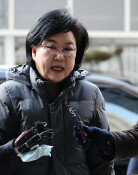Restoring the Middle Class
The Korea Development Institute released Thursday a study on changes in the distribution of income class over the past decade. Based on disposable income, the middle class steadily declined from 68.5 percent of households in 1996 before the Asian financial crisis to 61.9 percent in 2000, 58.5 percent in 2006, and 56.7 percent last year. By contrast, the rate for the upper class rose from 20.2 percent in 1996 to 24.1 percent last year, and that of the poor also increased from 11.3 percent to 19.2 percent over the same period. Samsung Economic Research Institute also said the share of middle-income households dropped from 60.4 percent in 2003 to 55.5 percent last year.
The Organization for Economic Cooperation and Development defines the middle class as households that earn between 50 and 150 percent of a countrys median income. The studies of the two Korean think tanks based on the OECDs definition show that with a steep decline in the number of the middle class, middle-class people who became poor outnumbered those who joined the upper class.
The shrinking of the middle class has also plagued advanced economies such as the U.S., Japan and those in Europe. Japan, which had been considered a country whose population belonged to the middle class, is now called a wealth gap or lower-class" society after a decade of economic stagnation in the 1990s. The U.S. and Europe also saw their middle-class populations decline as jobs in services and manufacturing migrated to China and India. Koreas middle class, however, has shrunk faster than any other country over the past decade after seeing steady growth from the 1960s.
The middle class is the key to social stability. A burgeoning middle class helps social integration. By contrast, the rising number of middle-class people falling into poverty could ignite class conflict and social unrest and cause politicians to resort to populist policies. The fundamental and long-term solution to boost the middle class is economic growth. To this end, the government should simultaneously pursue the existing model of export-oriented growth along with raising domestic consumption. Another urgent task is to implement economic reform to nurture talent that can adapt to changing economic and industrial environments.
Koreas average wage has almost reached the level of advanced economies. To increase the number of middle-class households, the creation of high value-added jobs is necessary. The shortest way to add quality jobs is deregulation in high-end service sectors such as medical care, education, law and tourism and removal of entry barriers in such sectors. Large corporations that raised sufficient funds through exports should be allowed to enter high value-added services and green growth industries. Blasting this as preferential treatment for large corporations is an outdated perception.
In his farewell ceremony, outgoing Prime Minister Chung Un-chan said, Both a government that doesnt do what it must do and a government that believes it can do everything hurt the interests of the nation and people. What the Lee Myung-bak government must do is to restore the middle class by shifting its policy focus.





![“생수병, 버리지 말고 자르자”…주방 밀폐 용기 끝판왕 [알쓸톡]](https://dimg.donga.com/c/138/175/90/1/wps/NEWS/IMAGE/2026/01/06/133101939.3.png)

